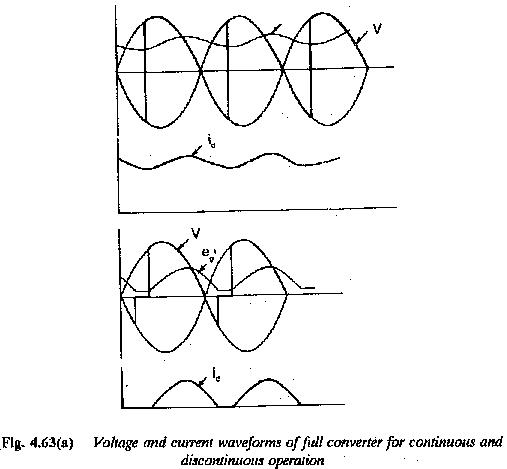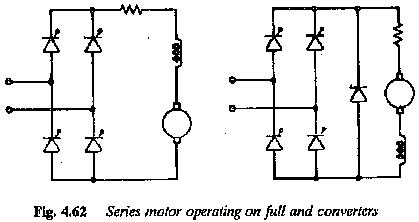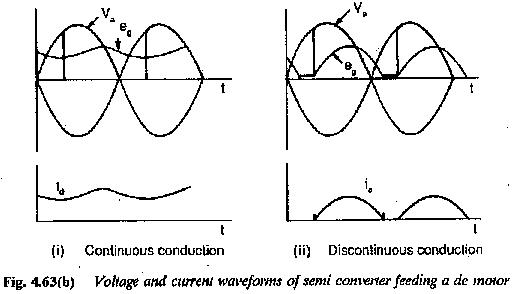Single Phase DC Series Motor Drives:
In the Single Phase DC Series Motor Drives the field is connected in series with the armature. The field current is the same as the armature current. The schematic of a Single Phase DC Series Motor Drives fed from a phase controlled converter is shown in Fig. 4.62. DC Series Motor are capable of high starting torque and constant power operation at all speeds. They are used in traction, cranes, hoists, etc. The waveforms of voltage and current of a series motor fed from a thyristor converter are shown in Fig. 4.63. Both continuous and discontinuous conduction are considered.
It is worth noting the differences in the operation of Single Phase DC Series Motor Drives and separately excited motors while operating on power converters. In a separately excited motor there is always a back emf present which actually accelerates the decay of armature current, thereby making discontinuous conduction occur, particularly at low currents. Discontinuous conduction occurs over a wide range of operating conditions, on the other hand, in series motors; the back emf being proportional to does not contribute to discontinuous conduction very much. As the motor current decreases it tends to become continuous, unlike in the case of a separately excited motor. Therefore the current of a Single Phase DC Series Motor Drives is continuous over a wide range of speeds. It may become discontinuous at high speeds and low currents of the motor. In this mode the motor terminal voltage is the same as back emf due to residual magnetism. The ratios of peak/average and rms/average currents of a DC Series Motor are smaller than those of a separately excited motor.
Another point of difference, which is also a reason for better performance of a DC Series Motor compared to a separately excited one, is the smoothing effect provided by field inductance, which effectively increases the circuit inductance. If a further improvement is required in the performance, a small inductance is sufficient.
A comparison of DC Series Motor operation on full and semi converters shows that the current is continuous in almost the entire region of operation when operating on semi converters. The addition of a small inductance makes the current continuous over the complete region. This can be seen also when the motor operates on a converter with FWD. The improvement in the performance can also be observed with respect to p.f. and ratios of peak to average and rms to average currents. This is due to the free wheeling of the current through the diodes of a semi converter or through the FWD of the converter with FWD.
A series motor has a torque-speed characteristic making it suitable for constant power operation. However, when it is fed from a converter it does not exhibit constant power operation at all speeds for a given firing angle. To achieve constant power at all speeds, adjustment of firing angle is required. A comparison of constant power operation of a series motor operating on full and semi converters show that it has better operation on semi converters with respect to power factor, discontinuous conduction, etc. Similar improvement in performance is possible using a full converter with a freewheeling diode.

